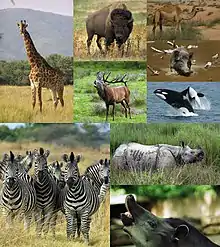| Pan-Euungulata Temporal range: Late Cretaceous to present | |
|---|---|
 | |
| Members of mirorder Euungulata | |
 | |
| Lower jaw of Protungulatum donnae | |
| Scientific classification | |
| Domain: | Eukaryota |
| Kingdom: | Animalia |
| Phylum: | Chordata |
| Class: | Mammalia |
| Grandorder: | Ferungulata |
| Clade: | Pan-Euungulata O'Leary, 2013[1] |
| Subgroups | |
| |
Pan-Euungulata (literally: "all true ungulates"; also known as: Euungulata [sensu lato][2]) is a clade of placental mammals from grandorder Ferungulata, consisting of the taxon Euungulata [sensu stricto] and all taxa (species) more closely related to it than to any other living species.[1]
The specification of the above-mentioned taxa related to Euungulata s.s. varies from author to author and changes over time.[1][3][4][5] The extinct family Protungulatidae is a typical representative of such taxa.[2][6]
Some (usually older) texts use the conceptually similar clade Ungulata in the broadest sense (and/or the clade Ungulatomorpha, which is Ungulata in the broadest sense plus Zhelestidae). This clade differs from Pan-Euungulata in that it also includes the taxon Paenungulata (i.e. for example Proboscidea, Sirenia and Hyracoidea) and sometimes also the taxa Tubulidentata and Dinocerata (and in the case of Ungulatomorpha also the taxon Zhelestidae).[7][8][9]
Classification and phylogeny
Classification
Clade: Pan-Euungulata (O'Leary, 2013)
- Family: †Protungulatidae (Chatterjee, Scotese & Bajpai, 2017)
- possibly other extinct taxa
- Mirorder: Euungulata (Waddell, 2001) (true ungulates)
- Clade: Pan-Perissodactyla (Welker, 2015)
- Clade: Paraxonia (Marsh, 1884)
See also
References
- 1 2 3 O’Leary, M. A., Bloch JI, Flynn, J. J., Gaudin, T. J., Giallombardo, A., Giannini, N. P., Goldber, S. L, Kraatz, B. P., Luo, Z-X, Jin Meng, Xijun Ni, Novacek, M. J., Perini, F. A., Randall, Z. S., Rougier, G. W., Sargis, E. J., Silcox, M. T., Simmons, N. B., Spaulding, M. Velazco, P. M., Weksler, M., Wible, J. R. Cirranello, A. L. (2013.) "The Placental Mammal Ancestor and the Post–K-Pg Radiation of Placentals." Science 339:6120:662-667. (Including Supplementary Material)
- 1 2 Averianov, A. O. & Lopatin, A. V. (2014.) "High-level systematics of placental mammals: Current status of the problem." Biology Bulletin, 41(9), 801–816.
- ↑ Michelle Spaulding, Maureen A. O'Leary, John Gatesy - Spaulding M, O'Leary MA, Gatesy J (2009) Relationships of Cetacea (Artiodactyla) Among Mammals: Increased Taxon Sampling Alters Interpretations of Key Fossils and Character Evolution. PLoS ONE 4(9): e7062. doi:10.1371/journal.pone.0007062
- ↑ Mark E. Samuels, Sophie Regnault, John R. Hutchinson (2017.) "Evolution of the patellar sesamoid bone in mammals" PeerJ.; 5: e3103
- ↑ Burger, Benjamin J. (2015-10-15). The Systematic Position of the Saber-Toothed and Horned Giants of the Eocene: The Uintatheres (Order Dinocerata) (PDF). Society of Vertebrate Paleontology 75th Annual Meeting. Dallas. Retrieved 2020-02-20. Conference abstract (p. 99). Explanation and conclusions: Episode 17: Systematic position of the Uintatheres (Order Dinocerata) on YouTube.
- ↑ Orliac, M. J.; o'Leary, M. A. (2016). "The inner ear of Protungulatum (Pan-Euungulata, Mammalia)". Journal of Mammalian Evolution. 23 (4): 337–352. doi:10.1007/s10914-016-9327-z. S2CID 133815599.
- ↑ "Ungulatomorpha". mv.helsinki.fi. 2007-11-17. Retrieved 2023-11-01.
- ↑ Unglatomorpha. palaeos.com. archived version: , accessed: 2023-11-01
- ↑ Averianov, Alexander, Archibald, J. David. Mammals from the mid-Cretaceous Khodzhakul Formation, Kyzylkum Desert, Uzbekistan. Cretaceous Research 26 (2005). page 595